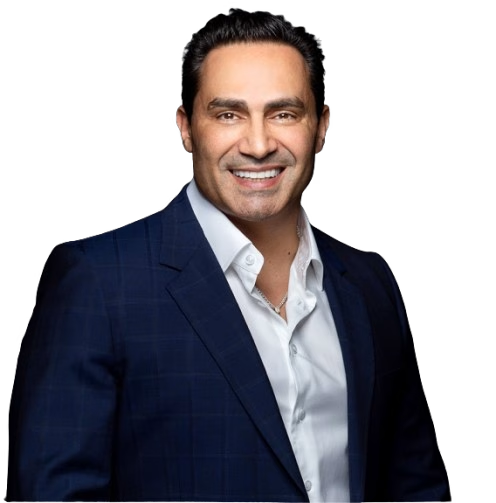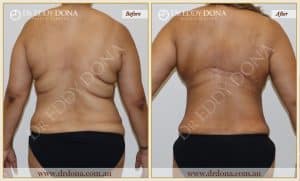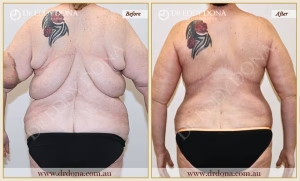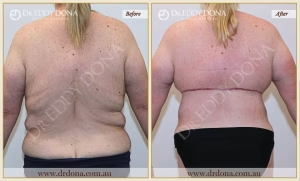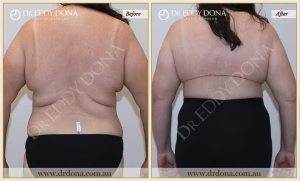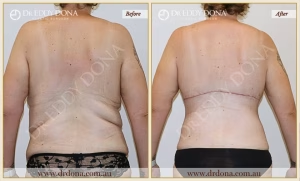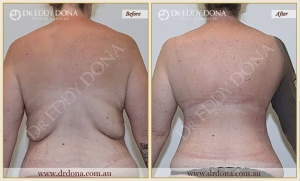Where is a Bra Lipectomy performed?
A Bra Lipectomy is performed in a Private Hospital, under General Anaesthetic.
Can I walk around when I get home after surgery?
When you return home, you will be encouraged to be up and as mobile as possible. However, you always want to listen to your body and mobilise within a range that is comfortable for you.
How much swelling can I expect after surgery?
You are placed in a garment immediately after surgery, that will help to manage your swelling. You will need to wear your garment for at least six weeks. You can expect to see a significant reduction in the initial swelling within the first two weeks following your surgery. In addition, it is not uncommon to see a slight difference in the swelling from one side to the other.
When can I go for a swim after surgery?
We will advise you to refrain from bathing or swimming until at least three weeks following your surgery.
How do I sleep after surgery?
There is no set sleeping position that is advised following your surgery – you can sleep in any position(s) that you are most comfortable in. However, you may find that sleeping on your back to be the most comfortable for the first few weeks.
What happens at my first clinic appointment?
Leave your dressings intact until your first post-operative appointment. Generally speaking, your first appointment will be scheduled no later than the day following your hospital discharge. Within your first post-operative appointment, one of our friendly and caring post-operative nurses will inspect your wounds and administer light therapy treatment, aimed at optimizing your recovery. Our post-operative nurses will continue to see you, at least three times per week for the following few weeks, and of course, will be available to answer any questions in-between your in-clinic appointments.
Going to the toilet after a Bra Lipectomy (Bloating and Constipation)
It is very common after surgery to experience bloating and constipation. This is because you have just had surgery and therefore you will be less mobile. In addition, you will be administered strong pain medication which causes slowing of the bowels. You will be encouraged to consume plenty of fluids, maintain a high-fiber diet, along with some gentle laxatives (such as Movicol), to help restore your normal bowel habits.
You will be given Movicol whilst in hospital and are encouraged to continue with the above measures at home until your normal bowel habits return.
Reducing the risk of blood clots (DVT’s)
Every hospital patient, especially surgical patients, will be at increased risk of developing DVT’s in their legs. Therefore, we undertake a number of measures to reduce this risk which include:
-
- A special massage device that will be fitted on both legs to help promote blood flow and minimise the chance of any clots developing in your leg veins.
- Whilst you are in hospital you will be encouraged to do simple foot exercise such as tapping your feet or wriggling your toes. This is designed to activate your calf muscles and encourage blood flow and is another vital measure to help reduce the risk of blood clots.
- In addition to this, you will be given an injection, once per day, of a blood thinner called Clexane. Clexane will also help minimise DVT’s from forming.
- You may be required to give yourself an injection of Clexane once per day, for the first three weeks after you leave the Private Hospital – this will further reduce the risk of DVT’s.
- Mobilising regularly and remaining well hydrated state at all times is also recommended.
When can I start driving again after a Bra Lipectomy?
You should not consider driving for the first two weeks after surgery. After this time, you should only drive if you feel safe doing so.
When can I go back to work?
You will be able to return to a light office or a desk role at approximately two weeks post-surgery. Light hospitality work may be possible at four weeks post-surgery. Any employment that involves heavy lifting or straining must be avoided for six weeks.
When can I return to doing my normal activities and training after a Bra Lipectomy?
At six weeks post-surgery, you can gradually return to normal training and physical activities. Consider the first six weeks after surgery as RECOVERY, and after six weeks, consider all activities as REHABILITATION. Undertake any physical activities that you wish to do and be guided by your comfort and strength, which will slowly improve.
When can I start having sex after a Bra Lipectomy?
You can return to sexual activity at any stage with the following understanding:
- You should avoid any activities that increase your heart rate and blood pressure during the first couple of weeks, as this can increase the risk of swelling or bleeding problems.
- Your wounds or adjacent surgical area should not be firmly handled or vigorously manipulated for the first six weeks.
- If you engage in sexual activity during the first six weeks, you need to take on a very passive role.
- Remember that you should not undertake any physical activities where you need to strain, exert, or even stretch your upper body muscles for the first six weeks.
When can I expect to see my final surgical results after a Bra Lipectomy?
It will take at least six months before you are feeling “normal” and able to do all the things you could before surgery. It will be at this stage that we assess your final surgical results. However, the scars will take at least 12-24 months before they have matured.

